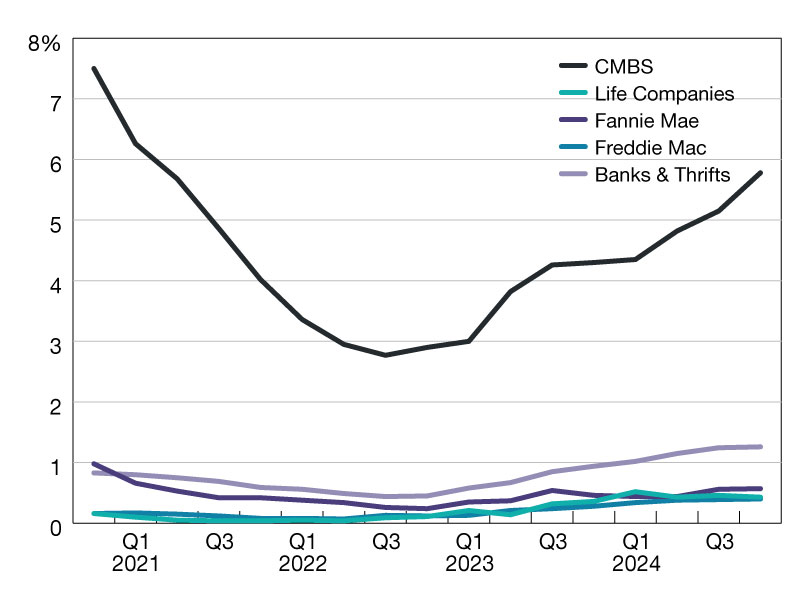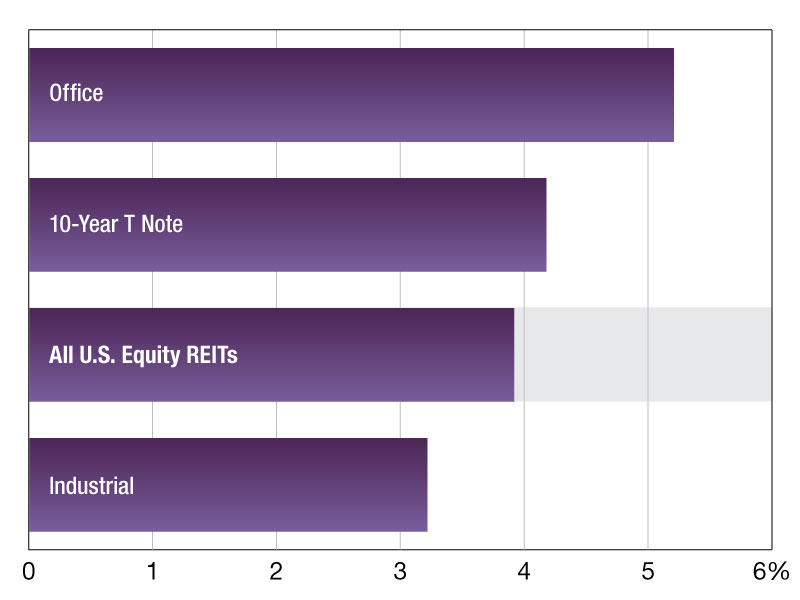Analysis: A Rule Change Could Fuel LifeCo CRE Investments
The easing of regulations around capital requirements could also improve returns on risk-based capital, according to Yardi Matrix Director of Research Paul Fiorilla.

After a years-long lobbying effort, the organization of state insurance commissioners that sets regulatory requirements for life insurers has reduced the capital requirements for investing in commercial properties, potentially opening the door for increased life company activity in the sector.
Approval of the change by the Life Risk-Based Capital Working Group of the National Association of Insurance Commissioners is part of a push to modernize risk-based capital requirements for real estate to more closely align with the historical risks of commercial property investing.
The new capital rules require that life companies hold 11 percent capital for commercial property equity investments—down from 15 percent before the regulations were revamped. For real estate equity investments that life companies hold in joint ventures, limited liability companies or a similar structure, the amount of risk-based capital required to be held was reduced to 13 percent—down from 23 percent. The new regulations go into effect for life company 2021 year-end risk-based capital reporting.
Reducing the risk-based capital requirements frees up more capital for life companies to invest in commercial properties and boosts the effective returns of investing in the sector. As a practical matter, the amount of capital involved is small relative to the total size of most life companies, but it makes commercial real estate more competitive as an investment product for them.
“Life companies can now get a better return on risk-based capital than before, which makes commercial real estate more attractive relative to other investments than it was before the change,” said Bruce Oliver, an associate vice president of commercial and multifamily policy at the Washington, D.C.-based Mortgage Bankers Association.
Modernizing Standards
Life companies and industry trade groups, including the MBA and American Council of Life Insurers initiated discussions with the NAIC working group in 2017 to reduce the capital requirements. Industry representatives contended that the previous requirements reflected a higher degree of risk for commercial real estate investments than is warranted by the sector’s historical performance.
In a letter of support for the proposal dated May 21, the MBA wrote that there was little data available on the performance of real estate when the current risk-based capital requirements were adopted in 2000.
“(T)he proposal is based on analysis of historical real estate investment performance data from the NCREIF Property Index, supplemented by further data … through earlier years of 1961-1977,” the letter stated. “MBA supports the proposed factor of 11 percent as a reasonable and conservative application of the results of that analysis.”
The letter noted that the higher risk weighting for joint venture investments “is based on an implicit assumption that the indirect real estate investments … are on average about 50 percent riskier than direct real estate investments.” Yet studies have demonstrated that the “performance of real estate held through joint ventures was consistent with and perhaps even slightly better than wholly-owned real estate.”
The life company coalition is also lobbying the life RBC working group on behalf of a proposal that would further reduce risk-based capital requirements for properties that are valued on the books at less than market value. The proposal would enable life companies to recognize a portion of unrealized gains on properties that, for example, appreciate over time.
As an illustration, the risk-based capital charge for a property with a market value of $15 million that is on the books at $10 million would be reduced to account for some portion of the $5 million in unrealized value to further reduce the amount of regulatory capital a life company would be required to hold for that property. This change was part of the original real estate proposal, but the working group deferred it to allow time to work through operational accounting and valuation issues.
Revamping CMBS Regulations
The actions taken by the NAIC only impact commercial real estate equity, not debt investments by life companies. Separately, NAIC working groups are also listening to similar proposals to update risk-based capital requirements for CMBS. These updates also would involve reducing capital requirements that would make it less onerous for life companies to invest in bonds backed by commercial mortgages and REITs.
The rationale for the changes would be to put the capital charges for CMBS more in line with the actual risk posed by the security. As with the changes in the equity capital requirements, that could make CMBS more attractive to life companies relative to competing investment products.
The CMBS proposal is being heard by the NAIC’s Valuation Securities Task Force. Under the proposal, the current six-factor designation system that regulates the capital charges that apply to a security purchased by a life company would be expanded to include up to 20 different factors. Those factors revolve around metrics that include the bond’s ratings and potential losses of the instrument being purchased.
The proposed update encompasses changing the model from the current way risk-based capital is calculated for CMBS to one based on performance through the cycle. Proponents of the changes note that the current risk-based capital requirements treat CMBS as a riskier product than its historical performance would indicate. They note that AAA-rated CMBS has produced virtually no losses in its entire history, going back more than 30 years.







You must be logged in to post a comment.